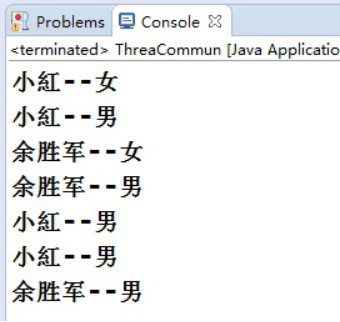什么是多线程之间通讯?
多线程之间通讯,其实就是多个线程在操作同一个资源,但是操作的动作不同。
画图演示
多线程之间通讯需求
需求:第一个线程写入(input)用户,另一个线程取读取(out)用户.实现读一个,写一个操作。

代码实现基本实现
共享资源源实体类
|
class Res { public String userSex; public String userName; } |
输入线程资源
|
class IntThrad extends Thread { private Res res; public IntThrad(Res res) { this.res = res; } @Override public void run() { int count = 0; while (true) { if (count == 0) { res.userName = "余胜军"; res.userSex = "男"; } else { res.userName = "小紅"; res.userSex = "女"; } count = (count + 1) % 2; } } } |
输出线程
|
class OutThread extends Thread { private Res res;
public OutThread(Res res) { this.res = res; }
@Override public void run() { while (true) { System.out.println(res.userName + "--" + res.userSex); } } } |
运行代码
|
Res res = new Res(); IntThrad intThrad = new IntThrad(res); OutThread outThread = new OutThread(res); intThrad.start(); outThread.start(); |
运行代码

解决线程安全问题注意:数据发生错乱,造成线程安全问题
IntThrad 加上synchronized
|
class IntThrad extends Thread { private Res res; public IntThrad(Res res) { this.res = res; } @Override public void run() { int count = 0; while (true) { synchronized (res) { if (count == 0) { res.userName = "余胜军"; res.userSex = "男"; } else { res.userName = "小紅"; res.userSex = "女"; } count = (count + 1) % 2; } } } } |
输出线程加上synchronized
|
class Res { public String userName; public String sex; }
class InputThread extends Thread { private Res res;
public InputThread(Res res) { this.res = res; }
@Override public void run() { int count = 0; while (true) { synchronized (res) { if (count == 0) { res.userName = "余胜军"; res.sex = "男"; } else { res.userName = "小红"; res.sex = "女"; } count = (count + 1) % 2; }
} } }
class OutThrad extends Thread { private Res res;
public OutThrad(Res res) { this.res = res; }
@Override public void run() { while (true) { synchronized (res) { System.out.println(res.userName + "," + res.sex); } }
} }
public class ThreadDemo01 {
public static void main(String[] args) { Res res = new Res(); InputThread inputThread = new InputThread(res); OutThrad outThrad = new OutThrad(res); inputThread.start(); outThrad.start(); }
}
|
wait、notify方法
1.因为涉及到对象锁,他们必须都放在synchronized中来使用. Wait、Notify一定要在synchronized里面进行使用。
2.Wait必须暂停当前正在执行的线程,并释放资源锁,让其他线程可以有机会运行
3. notify/notifyall: 唤醒因锁池中的线程,使之运行
4. wait()、notify/notifyAll() 方法是Object的本地final方法,无法被重写。
|
class Res { public String userSex; public String userName; //线程通讯标识 true 允许读 不允许写 false 允许写 不允许读 public boolean flag = false; }
|
|
class IntThrad extends Thread { private Res res; public IntThrad(Res res) { this.res = res; } @Override public void run() { int count = 0; while (true) { synchronized (res) { if (res.flag) { try { // 当前线程变为等待,但是可以释放锁 res.wait(); } catch (Exception e) { } } if (count == 0) { res.userName = "余胜军"; res.userSex = "男"; } else { res.userName = "小紅"; res.userSex = "女"; } count = (count + 1) % 2; res.flag = true; // 唤醒当前线程 res.notify(); } } } } |
|
class OutThread extends Thread { private Res res; public OutThread(Res res) { this.res = res; } @Override public void run() { while (true) { synchronized (res) { if (!res.flag) { try { res.wait(); } catch (Exception e) { // TODO: handle exception } } System.out.println(res.userName + "--" + res.userSex); res.flag = false; res.notify(); } } } } |
|
public class ThreaCommun { public static void main(String[] args) { Res res = new Res(); IntThrad intThrad = new IntThrad(res); OutThread outThread = new OutThread(res); intThrad.start(); outThread.start(); } } |
wait与sleep区别
对于sleep()方法,我们首先要知道该方法是属于Thread类中的。而wait()方法,则是属于Object类中的。
sleep()方法导致了程序暂停执行指定的时间,让出cpu该其他线程,但是他的监控状态依然保持者,当指定的时间到了又会自动恢复运行状态。
在调用sleep()方法的过程中,线程不会释放对象锁。
而当调用wait()方法的时候,线程会放弃对象锁,进入等待此对象的等待锁定池,只有针对此对象调用notify()方法后本线程才进入对象锁定池准备
获取对象锁进入运行状态。
Lock锁
在 jdk1.5 之后,并发包中新增了 Lock 接口(以及相关实现类)用来实现锁功能,Lock 接口提供了与 synchronized 关键字类似的同步功能,但需要在使用时手动获取锁和释放锁。
Lock写法
|
Lock lock = new ReentrantLock(); lock.lock(); try{ //可能会出现线程安全的操作 }finally{ //一定在finally中释放锁 //也不能把获取锁在try中进行,因为有可能在获取锁的时候抛出异常 lock.ublock(); } |
Lock与synchronized 关键字的区别
Lock 接口可以尝试非阻塞地获取锁 当前线程尝试获取锁。如果这一时刻锁没有被其他线程获取到,则成功获取并持有锁。
Lock 接口能被中断地获取锁 与 synchronized 不同,获取到锁的线程能够响应中断,当获取到的锁的线程被中断时,中断异常将会被抛出,同时锁会被释放。
Lock 接口在指定的截止时间之前获取锁,如果截止时间到了依旧无法获取锁,则返回。
Condition用法
Condition的功能类似于在传统的线程技术中的,Object.wait()和Object.notify()的功能。
代码
|
Condition condition = lock.newCondition(); res. condition.await(); 类似wait res. Condition. Signal() 类似notify |
|
class Res { public String userName; public String sex; public boolean flag = false; Lock lock = new ReentrantLock(); } class InputThread extends Thread { private Res res; Condition newCondition; public InputThread(Res res, Condition newCondition) { this.res = res; this.newCondition=newCondition; } @Override public void run() { int count = 0; while (true) { // synchronized (res) { try { res.lock.lock(); if (res.flag) { try { // res.wait(); newCondition.await(); } catch (Exception e) { // TODO: handle exception } } if (count == 0) { res.userName = "余胜军"; res.sex = "男"; } else { res.userName = "小红"; res.sex = "女"; } count = (count + 1) % 2; res.flag = true; // res.notify(); newCondition.signal(); } catch (Exception e) { // TODO: handle exception }finally { res.lock.unlock(); } } // } } } class OutThrad extends Thread { private Res res; private Condition newCondition; public OutThrad(Res res,Condition newCondition) { this.res = res; this.newCondition=newCondition; } @Override public void run() { while (true) { // synchronized (res) { try { res.lock.lock(); if (!res.flag) { try { // res.wait(); newCondition.await(); } catch (Exception e) { // TODO: handle exception } } System.out.println(res.userName + "," + res.sex); res.flag = false; // res.notify(); newCondition.signal(); } catch (Exception e) { // TODO: handle exception }finally { res.lock.unlock(); } // } } } } public class ThreadDemo01 { public static void main(String[] args) { Res res = new Res(); Condition newCondition = res.lock.newCondition(); InputThread inputThread = new InputThread(res,newCondition); OutThrad outThrad = new OutThrad(res,newCondition); inputThread.start(); outThrad.start(); } } |